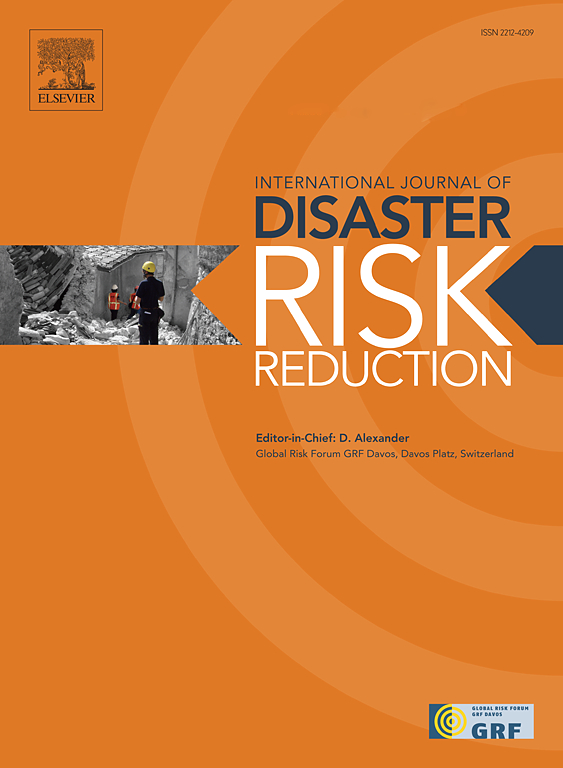The impact of educational and training programs on disaster awareness and preparedness among health sciences students: A quasi-experimental study
IF 4.2
1区 地球科学
Q1 GEOSCIENCES, MULTIDISCIPLINARY
International journal of disaster risk reduction
Pub Date : 2024-10-15
DOI:10.1016/j.ijdrr.2024.104888
引用次数: 0
Abstract
Disaster preparedness among health sciences students is critical but often insufficient. This study evaluates the effectiveness of a disaster awareness and impact reduction educational intervention in enhancing disaster preparedness. A quasi-experimental single-group pretest-posttest design was employed, with the intervention consisting of 16 h of education delivered over four weeks via a distance learning platform. The study involved 599 students from the faculties of health sciences, who were assessed at baseline and three months post-intervention. Results indicated that students’ baseline disaster preparedness levels were low, with no significant correlations found between demographic characteristics, previous disaster experiences, or prior disaster preparedness training and baseline preparedness levels. Repeated-measures Analysis of Variance confirmed a significant impact of the intervention after controlling for baseline preparedness levels. Significant improvements were observed post-intervention across all preparedness dimensions: disaster physical protection, disaster planning, disaster assistance, disaster warning systems, and total preparedness levels (p < .001). The most substantial gains were noted among students with initially low preparedness levels. These findings emphasize the importance of integrating disaster preparedness education into health sciences curricula to better equip future healthcare professionals for effective disaster response.
教育和培训计划对健康科学专业学生的灾难意识和防备能力的影响:准实验研究
健康科学专业学生的备灾能力至关重要,但往往不足。本研究评估了灾害意识和减少影响教育干预在提高备灾能力方面的效果。研究采用了准实验性的单组前测后测设计,干预措施包括通过远程学习平台在四周内提供 16 小时的教育。研究涉及 599 名健康科学学院的学生,他们分别在基线和干预后三个月接受了评估。结果表明,学生的基线备灾水平较低,人口统计学特征、以往的灾难经历或之前的备灾培训与基线备灾水平之间没有发现明显的相关性。重复测量方差分析证实,在控制了基线防灾水平后,干预措施产生了重大影响。干预后,学生在所有备灾维度上都有了显著提高:灾害实物保护、灾害规划、灾害援助、灾害预警系统和总体备灾水平(p <.001)。最初备灾水平较低的学生的备灾水平提高幅度最大。这些发现强调了将备灾教育纳入健康科学课程的重要性,以更好地培养未来的医疗保健专业人员有效地应对灾害。
本文章由计算机程序翻译,如有差异,请以英文原文为准。
求助全文
约1分钟内获得全文
求助全文
来源期刊

International journal of disaster risk reduction
GEOSCIENCES, MULTIDISCIPLINARYMETEOROLOGY-METEOROLOGY & ATMOSPHERIC SCIENCES
CiteScore
8.70
自引率
18.00%
发文量
688
审稿时长
79 days
期刊介绍:
The International Journal of Disaster Risk Reduction (IJDRR) is the journal for researchers, policymakers and practitioners across diverse disciplines: earth sciences and their implications; environmental sciences; engineering; urban studies; geography; and the social sciences. IJDRR publishes fundamental and applied research, critical reviews, policy papers and case studies with a particular focus on multi-disciplinary research that aims to reduce the impact of natural, technological, social and intentional disasters. IJDRR stimulates exchange of ideas and knowledge transfer on disaster research, mitigation, adaptation, prevention and risk reduction at all geographical scales: local, national and international.
Key topics:-
-multifaceted disaster and cascading disasters
-the development of disaster risk reduction strategies and techniques
-discussion and development of effective warning and educational systems for risk management at all levels
-disasters associated with climate change
-vulnerability analysis and vulnerability trends
-emerging risks
-resilience against disasters.
The journal particularly encourages papers that approach risk from a multi-disciplinary perspective.
 求助内容:
求助内容: 应助结果提醒方式:
应助结果提醒方式:


